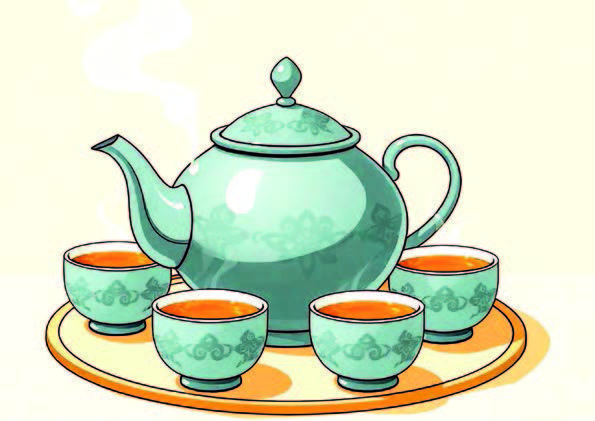By Myint Zan
MANLE Sayadaw (1842- 1921) and Ledi Sayadaw (1 December 1846-27 June 1923) were contemporary Buddhist monk-scholars who made notable contributions to Buddhist doctrine in their discourses and writings which have enriched Myanmar literature.
In the 17 and 24 November 2024 issues of The Global New Light of Myanmar, I have translated and reproduced the original vernacular two poems (in a sense ‘doggerels’) written by the two revered monks. The poem by Manle Sayadaw deals with the disadvantages, indeed one could say negative consequences of drinking tea. On the other hand, Ledi Sayadaw listed the benefits of drinking tea and complimented the tea drinkers. The two poems appeared one after the other in the booklet Selected Burmese Poems for 1st and 2nd-year students at the University of Mandalay first published in October 1986.
It is presumable that the poem by Ledi Sayadaw praising the benefits of drinking tea was composed by him after he came across the elder (in age) Manle Sayadaw’s poem censuring tea drinkers. In the mid-18th to early 20th century when the two poems were supposedly composed there was no postal service, not to say radio or telegrams (perhaps). Facebook, Viber and WhatsApp were much more than a century away in the future. Hence it must have been several weeks or a few months before Ledi Sayadaw came across Manle Sayadaw’s poem listing the negative effects of tea drinking. Or — this is only a guess — were there literary symposia during the last two kings of Upper Burma? In the days of King Mindon (8 July 1808-1 October 1878, reigned 1853-78) and King Thibaw (1 January 1859-19 December 1916, reigned 1878-85) there could be literary symposia in court. The two Sayadaws must have been between the ages of 22 to 44 (Manle Sayadaw) and the ages of 18-39 (Ledi Sayadaw) during the reigns of Mindon and Thibaw. Did either of the two kings request the two revered monks to compose poems about the advantages and disadvantages of drinking tea? Perhaps or perhaps not.
One wonders what ‘triggered’ Manle Sayadaw to compose the ‘anti-tea-drinking poem’ or for that matter on the off-chance that it was Ledi Sayadaw who first composed the ‘pro-tea-drinking’ poem what prompted Ledi Sayadaw to do so.
I am not aware whether there were — or not — other poems or indeed discourses by the two revered monks where they did not see eye to eye on things not only about tea drinking but also on other mundane as well as religious matters.
The rivalry between two Buddhist monks of the 15th to 16th centuries: Shin Maharatha Ratthasara and Shin Maha Silavamsa
Two Buddhist monks contemporaneously flourished in the mid-15th to early-16th centuries. Their contributions to Myanmar literature are also very significant. Indeed, it could be stated that they are landmarks in medieval Burmese literature. They were Shin (Shin is not a ‘first name’ as such but an honorific denoting, a learned monk) Maha (Maha is also an honorific generally meaning ‘great’) Ratthasara (1468-1529) (hereafter Ratthasara) and Shin Maha Silavamsa (1453-1518) (hereafter Silavamsa). Silavamsa is 15 years older than Ratthasara.
I have ‘wondered’ above whether Manle Sayadaw and Ledi Sayadaw were requested by the two last Burmese kings to compose on the topic of drinking tea. But over three centuries earlier in the palace of the then Innwa (Ava) kings there were literary symposiums where the two monks Silavamsa and Ratthasara were (shall we say) enjoined to compose poems, prose and other literary genres before a live audience. Myanmar language and literature scholars throughout the centuries have debated and expressed their views on the comparative literary contributions, styles and merits of the two medieval monks.
Scholars have stated their views as to whose literary work Silavamsa or Ratthasara were ‘better’ or ‘superior’. One epigram whose origin this writer does not know states to the effect that Silavamsa’s literary achievements were like diamonds cutting not merely through baskets (Taung Go Ma Phaut) but through the mountains (Taun Go Phaut Thi). Hence Silavamsa’s literary products were like diamonds (Sain Kyaut A-thwin Thila Win). In comparison or indeed in contrast Ratthathara’s literary prose and poetry are merely thorn-like tools which pierced baskets but not mountains (Taun Go Ma Phaut Taung Go Phaut Thi Hsu Hsauk Pamar Ratta Tha).
From the above statement, it is clear that the writer(s) of the epigram were of the view that Silavamsa was the ‘superior’ literati. Was Silavamsa superior in all or most of his literary products compared to Ratthasara? In his most recent book titled (in translation) Myanmar Language: References to Sixty Treatises (published November 2024) Saya Maung Khin Min (Danubyu) (born 2 January 1942) quoted Bagan Wun Htauk U Tin (1861-1933) who himself referred to Kinwun Mingyi U Kaung (3 February 1822-30 June 1908). Kinwun Mingyi stated that Silavamsa’s poetry is good in meaning and is inspiring. Kinwun Mingyi stated though that as to rhyme and cadence Ratthasara was the superior writer (on page 23 of Maung Khin Min’s book).
Almost certainly there could be a comparative commentary on the literary contributions of the two scholar monks of the mid- 19th to early 20th century (Manle Sayadaw and Ledi Sayadaw) as there were perhaps more extensive analyses and commentaries of the two monk-poet-literati of the mid-15th to early 16th century.
Are there any Master’s or doctoral theses in the Myanmar language in the various Departments of Myanmar comparing the literary contributions of Manle Sayadaw and Ledi Sayadaw? If there are any books or treatises comparing the literary flair, styles and contributions of Manle Sayadaw and Ledi Sayadaw in both Myanmar and even in the English language yours truly would appreciate learning from them.


